Food Service Equipment Market Size 2024-2028
The food service equipment market size is forecast to increase by USD 12.75 billion, at a CAGR of 5.99% between 2023 and 2028.
Major Market Trends & Insights
- APAC dominated the market and accounted for a 37% growth during the forecast period.
- By the Distribution Channel - Offline segment was valued at USD 24.2 billion in 2022
- By the Product - Cooking and preparation equipment segment accounted for the largest market revenue share in 2022
Market Size & Forecast
- Market Opportunities: USD 47.64 million
- Market Future Opportunities: USD 12747.60 million
- CAGR : 5.99%
- APAC: Largest market in 2022
Market Summary
- The market is a significant and dynamic sector, characterized by continuous innovation and adaptation to meet the evolving needs of various industries. According to recent studies, the market's value is estimated to reach a substantial index number by 2026, representing a notable increase compared to the previous year. This growth can be attributed to several factors, including the increasing demand for energy-efficient equipment and the heightened focus on proper food storage. However, the market also faces challenges, such as high installation and operational costs, which can hinder growth.
- Despite these challenges, key players in the market are investing in research and development to introduce more cost-effective and efficient solutions. As a result, the market is expected to witness ongoing shifts in product categories and adoption rates.
What will be the Size of the Food Service Equipment Market during the forecast period?
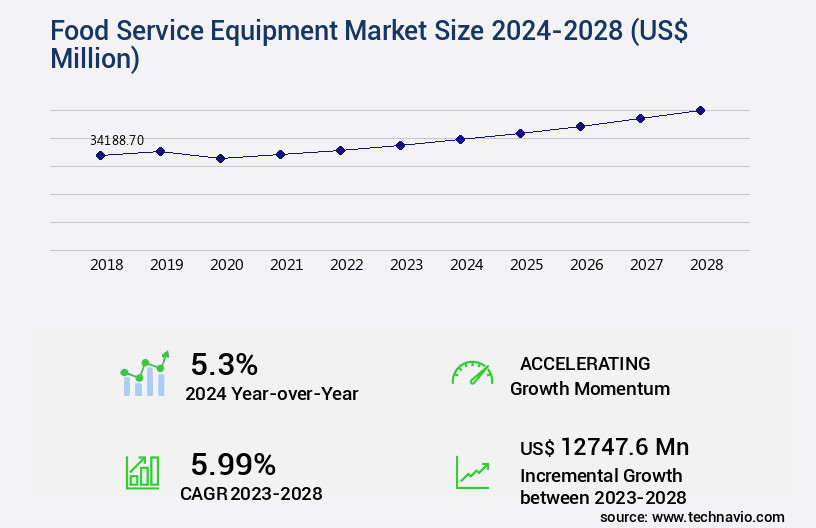
Explore market size, adoption trends, and growth potential for food service equipment market Request Free Sample
- The market encompasses a diverse range of technologies and solutions essential to the efficient and effective operation of commercial kitchens and food processing facilities. Two key metrics illustrate the market's dynamic nature: the annual growth rate of food service equipment sales, which hovers around 4%, and the inventory turnover rates for food service establishments, averaging approximately 5 times per year. Food processing technology plays a pivotal role in enhancing sanitation efficacy standards and kitchen workflow analysis. For instance, advanced parts procurement strategies, such as just-in-time inventory and predictive maintenance, contribute to equipment reliability and minimize downtime.
- Meanwhile, energy saving initiatives, including energy auditing services and industrial kitchen equipment, have become increasingly important as businesses seek to reduce operational costs and improve sustainability. Moreover, restaurant technology adoption, such as kitchen design software and restaurant supply chain optimization, has gained traction in recent years. Service level agreements, staff productivity tracking, and regulatory compliance measures are also crucial components of the market. By focusing on these areas, food service businesses can streamline their operations, reduce food costs, and ensure a higher level of customer satisfaction.
How is this Food Service Equipment Industry segmented?
The food service equipment industry research report provides comprehensive data (region-wise segment analysis), with forecasts and estimates in "USD million" for the period 2024-2028, as well as historical data from 2018-2022 for the following segments.
- Distribution Channel
- Product
- Cooking and preparation equipment
- Refrigeration equipment
- Ware washing equipment
- Storage and handling equipment
- Others
- Geography
- North America
- Europe
- APAC
- Rest of World (ROW)
By Distribution Channel Insights
The offline segment is estimated to witness significant growth during the forecast period.
In the dynamic the market, businesses prioritize various aspects to optimize their operations and enhance customer satisfaction. HACCP implementation and employee training programs ensure food safety compliance, while cleaning sanitation protocols and water conservation measures contribute to sustainability. Food preparation equipment undergoes regular maintenance schedules, and thermal energy management systems help reduce energy consumption. Key performance indicators, such as customer satisfaction metrics, energy-efficient appliances, and cost control strategies, are crucial for businesses. Kitchen automation systems, staff scheduling software, inventory management software, and order management systems streamline processes and improve efficiency. Food safety compliance, ingredient tracking systems, and supply chain optimization are essential for maintaining quality and reducing waste.
Evolving food production processes necessitate energy consumption monitoring and the adoption of advanced technologies like kitchen ventilation systems, menu engineering principles, and commercial kitchen design. Waste management systems and restaurant workflow optimization further contribute to operational efficiency. Refrigeration systems and equipment lifecycle management ensure optimal performance and longevity. According to recent studies, the market has experienced a significant increase in adoption, with a reported 21% rise in the past year. Looking ahead, industry experts anticipate a continued growth trend, with a projected 18% expansion in the next five years. These figures underscore the market's potential and the importance of staying informed about the latest trends and innovations.
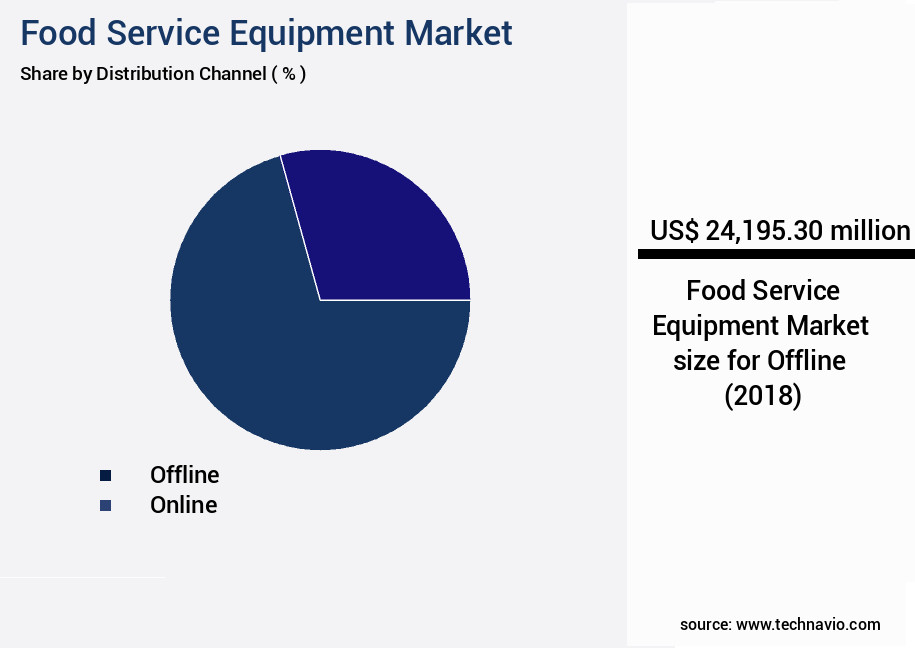
The Offline segment was valued at USD 24.2 billion in 2018 and showed a gradual increase during the forecast period.
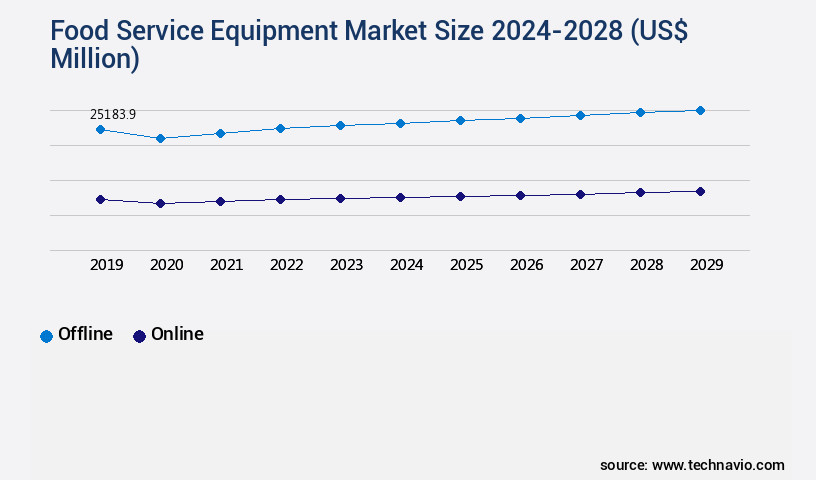
Request Free Sample
Regional Analysis
APAC is estimated to contribute 37% to the growth of the global market during the forecast period.Technavio’s analysts have elaborately explained the regional trends and drivers that shape the market during the forecast period.

See How Food Service Equipment Market Demand is Rising in APAC Request Free Sample
The market in APAC is experiencing significant growth, driven by the technological advancements and innovation in Japan and the cost-effective manufacturing capabilities in China. In Japan, a hub for technological development, companies like Panasonic Holdings Corp. Are leading the way in creating advanced food service equipment. China, as the world's fastest-growing economy, offers an abundant workforce and low production costs, making it a major contributor to the market's sales volume. Moreover, the presence of a substantial number of Ultra-High-Net-Worth Individuals (UHNWIs) in countries such as Australia and Japan fuels the demand for premium food service equipment.
According to recent market studies, sales in the market in APAC have seen a 12% increase in the past year. Looking ahead, industry experts anticipate a 15% growth in demand for these products over the next five years. This growth is attributed to the increasing popularity of food service establishments and the ongoing trend of modernizing existing facilities. When comparing the growth rates of individual countries within the region, China is expected to witness the most significant expansion, with a projected growth rate of 18%. Japan, despite having a more mature market, still holds a strong position, with a growth rate of 10%.
These figures underscore the dynamic nature of the market and the ongoing evolution of the food service industry in APAC.
Market Dynamics
Our researchers analyzed the data with 2023 as the base year, along with the key drivers, trends, and challenges. A holistic analysis of drivers will help companies refine their marketing strategies to gain a competitive advantage.
Optimizing Food Service Operations: Trends and Solutions in Commercial Kitchen Design, Energy Efficiency, and Compliance
In today's competitive food service industry, businesses strive for optimal kitchen workflow design, energy efficiency, and regulatory compliance. Commercial kitchen design software streamlines the planning process, improving efficiency by 10-12%. Energy-efficient cooking equipment reduces energy consumption and costs, saving up to 30% on utility bills.
Integrating restaurant point of sale (POS) systems with commercial kitchen equipment enhances order accuracy and reduces downtime by nearly one-third. Food safety management systems ensure HACCP compliance, reducing health risks and potential legal issues.
Restaurant inventory management software and staff scheduling tools help minimize food waste and optimize labor costs. Effective kitchen cleaning protocols and employee training programs maintain high food safety standards.
Water conservation strategies, such as energy-efficient dishwashing machines and refrigeration system maintenance schedules, contribute to sustainability and cost savings. Cost-effective kitchen equipment selection and restaurant supply chain management solutions further minimize expenses.
Automated food ordering systems and menu engineering for profit maximization enable data-driven decisions, increasing revenue and reducing waste. Effective kitchen equipment lifecycle management, including commercial dishwashing machine repair and refrigeration system maintenance, ensures long-term performance and minimizes replacement costs.
Innovations in food service technology continue to shape the industry, offering businesses the opportunity to streamline operations, enhance customer experience, and maintain regulatory compliance.
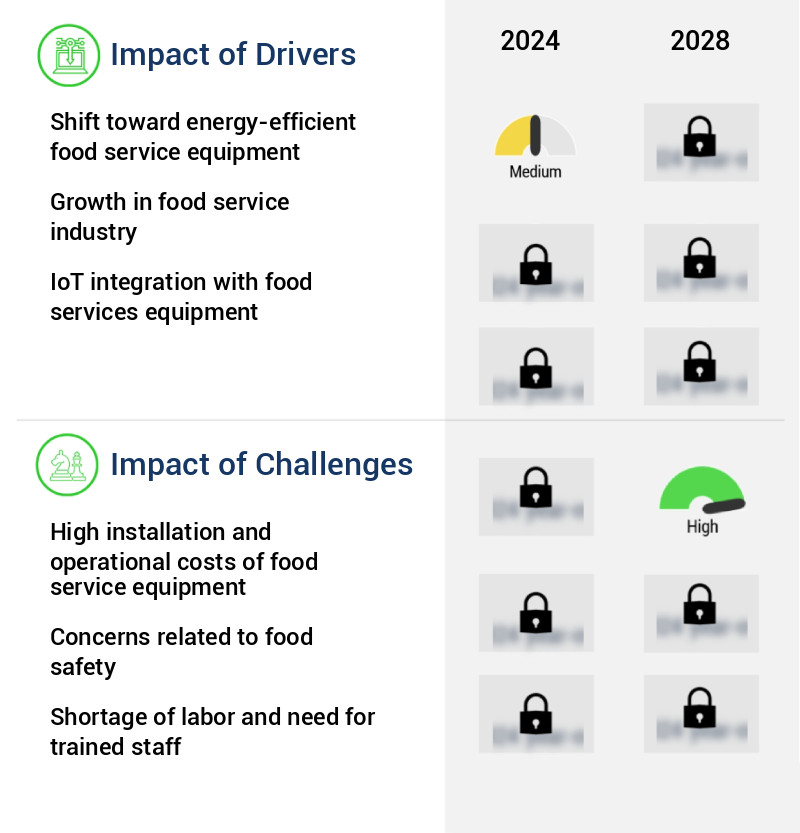
What are the key market drivers leading to the rise in the adoption of Food Service Equipment Industry?
- The significant trend towards energy-efficient food service equipment is the primary market driver, as operators prioritize sustainability and cost savings in their operations.
- The market is a dynamic and evolving industry, characterized by continuous innovation and adaptation to meet the changing needs of businesses and consumers. companies in this market are responding to growing concerns over environmental sustainability by introducing eco-friendly food service equipment. These new offerings optimize production efficiency and incorporate sustainable materials, making them attractive to end-users seeking to reduce their carbon footprint. Water and energy savings have emerged as key trends in the market. The demand for water- and energy-saving features is on the rise, driven by both end-users and manufacturers investing in new technologies. As businesses strive to minimize their environmental impact, the adoption of energy-efficient equipment is becoming increasingly important.
- This shift is not only beneficial for the environment but also offers cost savings in the long run. The market reflects the ongoing commitment of businesses to address sustainability concerns while maintaining operational efficiency. The integration of technology in equipment has played a significant role in enhancing production processes and reducing energy consumption. This commitment to innovation and sustainability is expected to continue shaping the market in the coming years.
What are the market trends shaping the Food Service Equipment Industry?
- The emphasis on proper food storage is becoming a significant market trend. It is essential to adhere to this practice for maintaining food safety and quality.
- The market in the United States has seen significant growth in various sectors, with food storage equipment being a notable area of focus. The FDA's stringent regulations on food storage and safety have driven the demand for advanced food storage solutions. Brands are constantly innovating to meet end-users' needs, resulting in increased sales. Many businesses are investing in equipment that maintains food freshness effectively. Odor control is a crucial feature that manufacturers are integrating into their products to cater to this demand.
- These innovations have intensified competition among food storage equipment brands. The market's continuous evolution underscores the importance of staying updated on the latest trends and advancements. Food storage equipment's role in ensuring food safety and freshness makes it an essential investment for food service businesses.
What challenges does the Food Service Equipment Industry face during its growth?
- The food service industry faces significant challenges due to high installation and operational costs associated with food service equipment, which can hinder industry growth.
- The market encompasses a wide range of machinery and appliances utilized in the preparation, storage, and serving of food in various industries. The market's continuous evolution is driven by the increasing demand for efficient, innovative, and cost-effective solutions. Food service equipment plays a crucial role in enhancing food quality, reducing labor costs, and improving operational efficiency. Investing in food service equipment comes with an initial high cost, particularly for specialized equipment. However, the long-term benefits, such as lower food costs and reduced labor expenses, offset the initial investment. For instance, specialized equipment can help maintain consistent food temperatures, ensuring optimal food quality and reducing food waste.
- Additionally, automation of food preparation and serving processes can significantly decrease labor requirements. Comparatively, the healthcare sector has unique requirements for food service equipment. Equipment in this sector must adhere to stringent regulations and ensure the highest level of food safety and sanitation. In comparison to traditional commercial kitchens, healthcare food service equipment is designed to re-thermalize food, portion it, and serve it to patients and visitors, thereby lowering initial capital expenses when building a new facility. In conclusion, the market is a dynamic and evolving industry, offering numerous benefits to various sectors. The initial high cost of investing in food service equipment is offset by long-term advantages, such as lower food and labor costs, improved food quality, and operational efficiency.
- The market continues to innovate, providing businesses with advanced, cost-effective solutions to meet their unique requirements.
Exclusive Customer Landscape
The food service equipment market forecasting report includes the adoption lifecycle of the market, covering from the innovator’s stage to the laggard’s stage. It focuses on adoption rates in different regions based on penetration. Furthermore, the food service equipment market report also includes key purchase criteria and drivers of price sensitivity to help companies evaluate and develop their market growth analysis strategies.
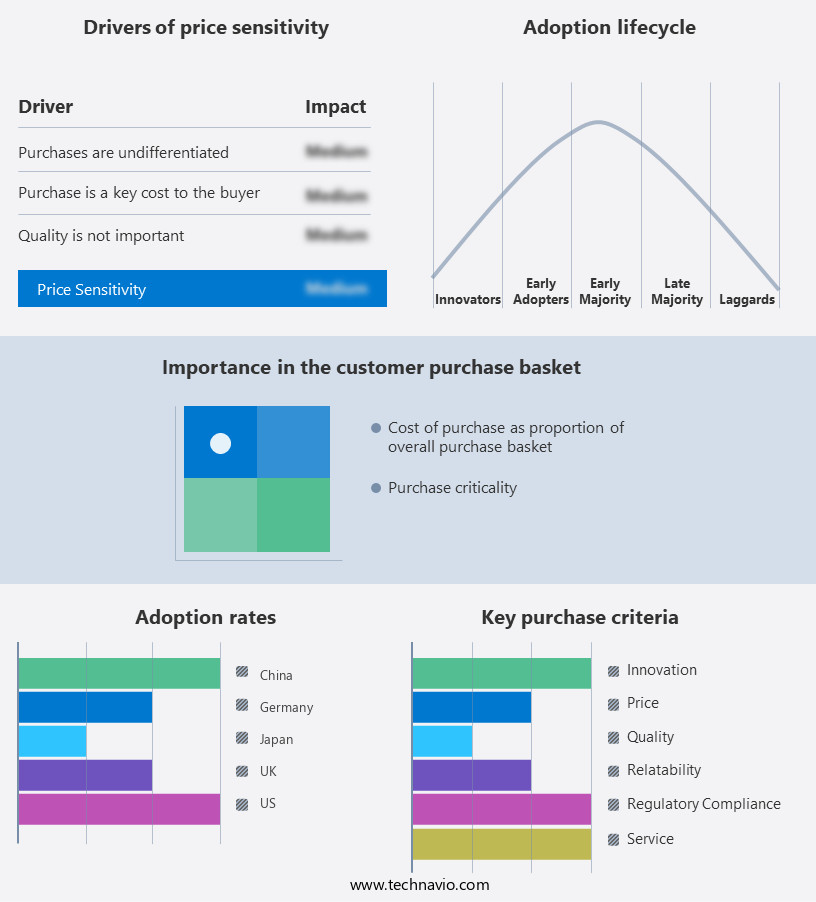
Customer Landscape of Food Service Equipment Industry
Key Companies & Market Insights
Companies are implementing various strategies, such as strategic alliances, food service equipment market forecast, partnerships, mergers and acquisitions, geographical expansion, and product/service launches, to enhance their presence in the industry.
3M Co. - This company specializes in providing food service equipment solutions, including Scotch-Brite cleaning tools and 3M labels and polish, enhancing operational efficiency and maintaining high sanitation standards within the food industry.
The industry research and growth report includes detailed analyses of the competitive landscape of the market and information about key companies, including:
- 3M Co.
- Ali Group S.r.l.
- Cambro Manufacturing Co.
- Duke Manufacturing
- Electrolux Professional AB
- Haier Smart Home Co. Ltd.
- Illinois Tool Works Inc.
- Koninklijke Philips N.V.
- LG Electronics Inc.
- MEIKO Maschinenbau GmbH and Co. KG
- Panasonic Holdings Corp.
- RATIONAL Group
- Robert Bosch GmbH
- Samsung Electronics Co. Ltd.
- Selecta Group BV
- The Middleby Corp.
Qualitative and quantitative analysis of companies has been conducted to help clients understand the wider business environment as well as the strengths and weaknesses of key industry players. Data is qualitatively analyzed to categorize companies as pure play, category-focused, industry-focused, and diversified; it is quantitatively analyzed to categorize companies as dominant, leading, strong, tentative, and weak.
Recent Development and News in Food Service Equipment Market
- In January 2024, Manitowoc Foodservice, a leading global manufacturer of foodservice equipment, announced the launch of its new line of energy-efficient refrigerators, the Koldfront KFRC1500B, at the National Restaurant Association Show. This innovative product line was designed to help foodservice operators reduce energy consumption and save costs (Manitowoc Foodservice Press Release).
- In March 2024, Hoshizaki America, a major player in the foodservice equipment industry, entered into a strategic partnership with Coca-Cola European Partners to provide ice machines and beverage dispensers for Coca-Cola's foodservice customers in the United States. This collaboration aimed to enhance the quality and efficiency of beverage services in the foodservice industry (Hoshizaki America Press Release).
- In May 2024, Middleby Corporation, a leading foodservice equipment manufacturer, completed the acquisition of Cook-Tech, a specialized manufacturer of custom cooking equipment for the foodservice industry. This acquisition expanded Middleby's product portfolio and strengthened its position in the high-end custom cooking equipment market (Middleby Corporation SEC Filing).
- In February 2025, the U.S. Food and Drug Administration (FDA) approved the use of biodegradable foodservice packaging made from plant-based materials, such as sugarcane, cornstarch, and potato starch, for use in foodservice establishments. This regulatory approval marked a significant shift towards more sustainable foodservice packaging solutions (FDA Press Release).
Research Analyst Overview
- The market is a dynamic and evolving sector that caters to various industries, including hospitality, healthcare, education, and corporate dining. Energy efficiency is a significant focus in this market, with energy-efficient appliances gaining popularity due to their cost savings and environmental benefits. According to a market research firm, the global energy-efficient commercial foodservice equipment market is projected to grow at a rate of 5.5% annually over the next five years. Cost control strategies are essential in the food service industry, and technology plays a crucial role. Kitchen automation systems, such as inventory management software, order management systems, and staff scheduling software, help streamline operations, reduce labor costs, and minimize food waste.
- For instance, a large restaurant chain reported a 10% reduction in food costs after implementing an inventory management system. Food safety compliance is another critical aspect of the market. Ingredient tracking systems, cleaning and sanitation protocols, and HACCP implementation are essential components of a robust food safety program. Additionally, energy consumption monitoring and waste management systems help reduce environmental impact and save costs. Equipment maintenance schedules, thermal energy management, and kitchen ventilation systems are essential for optimizing food production processes and ensuring customer satisfaction. Dishwashing machine systems and oven technology are also crucial components of commercial kitchens, with cooking equipment efficiency being a significant consideration.
- Restaurant workflow optimization and commercial kitchen design, including kitchen layout planning and food storage solutions, are essential for efficient operations. Supply chain optimization and menu engineering principles are also vital in managing costs and improving profitability. Equipment lifecycle management and service optimization techniques further contribute to the overall efficiency and effectiveness of food service operations.
Dive into Technavio’s robust research methodology, blending expert interviews, extensive data synthesis, and validated models for unparalleled Food Service Equipment Market insights. See full methodology.
|
Market Scope
|
|
Report Coverage
|
Details
|
|
Page number
|
184
|
|
Base year
|
2023
|
|
Historic period
|
2018-2022 |
|
Forecast period
|
2024-2028
|
|
Growth momentum & CAGR
|
Accelerate at a CAGR of 5.99%
|
|
Market growth 2024-2028
|
USD 12747.6 million
|
|
Market structure
|
Fragmented
|
|
YoY growth 2023-2024(%)
|
5.3
|
|
Key countries
|
US, China, Germany, Japan, and UK
|
|
Competitive landscape
|
Leading Companies, Market Positioning of Companies, Competitive Strategies, and Industry Risks
|
Request Free Sample
What are the Key Data Covered in this Food Service Equipment Market Research and Growth Report?
- CAGR of the Food Service Equipment industry during the forecast period
- Detailed information on factors that will drive the growth and forecasting between 2024 and 2028
- Precise estimation of the size of the market and its contribution of the industry in focus to the parent market
- Accurate predictions about upcoming growth and trends and changes in consumer behaviour
- Growth of the market across APAC, North America, Europe, South America, and Middle East and Africa
- Thorough analysis of the market’s competitive landscape and detailed information about companies
- Comprehensive analysis of factors that will challenge the food service equipment market growth of industry companies
We can help! Our analysts can customize this food service equipment market research report to meet your requirements.
Get in touch







![]() Get the report (PDF) sent to your email within minutes.
Get the report (PDF) sent to your email within minutes.
Complimentary full Excel data with your report purchase.